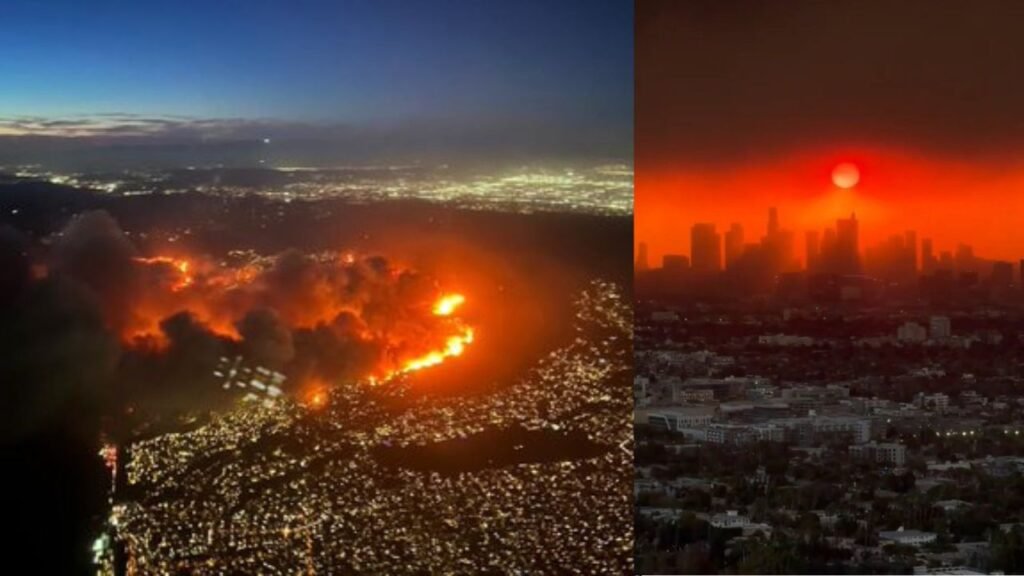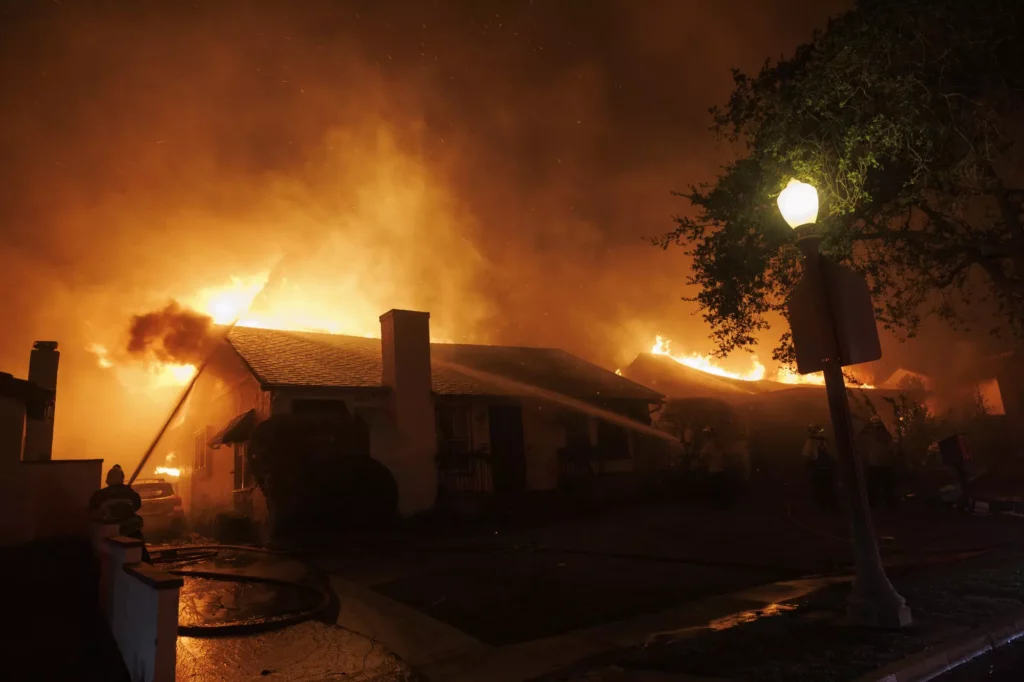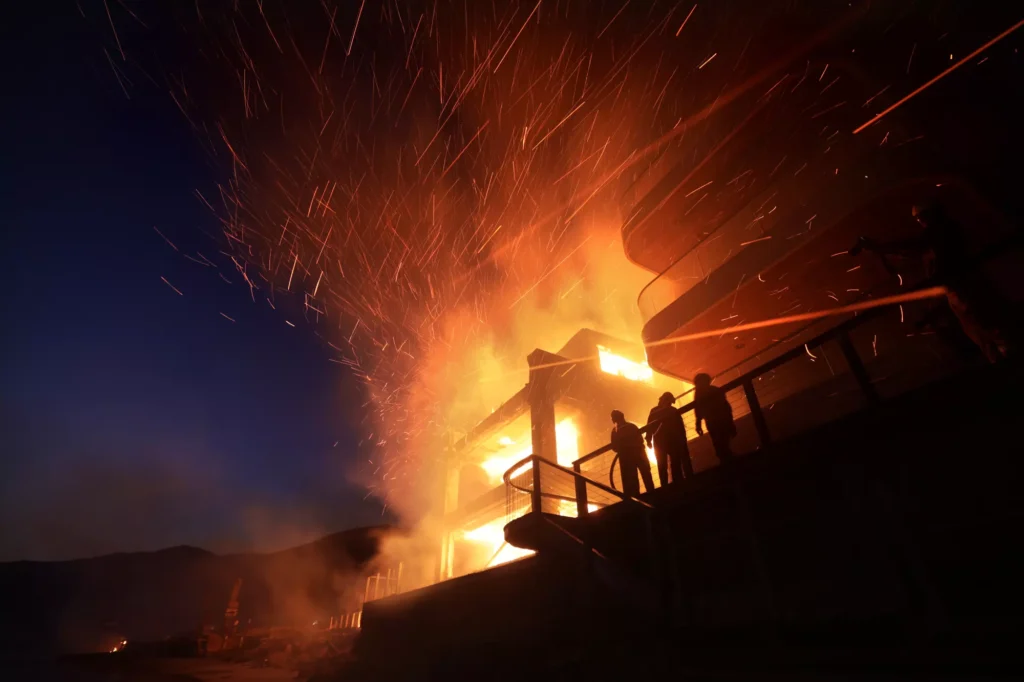In The Line Of Fire: Stories Of Survival And Loss In Southern California
- Leave a Comment
- James M
- January 9, 2025

The sun’s typical golden warmth gave way to a menacing red glare as it sank beyond the Pacific horizon. A dense layer of smoke covered the skies over Southern California, giving the coast a ghoulish orange tint.
The once-beautiful scenery changed to one of turmoil and devastation from Santa Monica to Malibu. A wind-driven conflagration, the Palisades fire continued to burn, destroying everything in its path and upsetting the tranquility of this peaceful coastal area.
Wednesday was a day of extraordinary proportions for Los Angeles, a city used to flames. With incredible intensity, the Palisades fire broke out, displacing thousands of people from their homes and enveloping the area in a dense fog.
Dream mansions were reduced to burning ruins as neighborhoods situated along canyon ridges were consumed by flames. Communities already under stress due to the continuous wildfire season now face danger and uncertainty as the fire spread more into the arid hillsides due to the unrelenting winds.
For the second or third time in a few weeks, residents of Brentwood, Topanga Canyon, and Malibu were thrown into chaos. As the fire spread, cell phone alerts sounded, demanding mandatory evacuations.
The horror was already a reality for some. The ashes of entire neighborhoods that had been engulfed by the Palisades fire served as a sobering reminder of the unforgiving force of nature. Burned palm trees and flaming trash dotted the famed Pacific Coast Highway, which was once a testament to the splendor of Southern California.
It is impossible to overestimate the importance of this day. The Palisades fire has turned into a somber representation of the difficulties brought on by both the unrelenting stress of wildfire seasons and climate change.
The fire is more than just a calamity to the people who live in this area; it is a personal tragedy, a challenge to fortitude, and a call to action. Los Angeles found itself at a crossroads as the sun fell on this terrifying day, confronting the harsh realities of a future that was becoming more and more characterized by fire.

The Palisades Fire's Scope
With startling rapidity, the Palisades fire broke out and swiftly swept over the arid, brush-covered foothills that overlooked the Pacific Ocean. A path of devastation was left behind as the fire ripped through canyons, fueled by relentless seasonal winds.
Homes and natural landscapes were consumed as flames jumped from ridge to ridge, engulfing entire neighborhoods. What started as a tiny spark grew into a massive catastrophe, solidifying its status as one of the most destructive wildfires Southern California has witnessed this season.
This fire follows a string of destructive fires that have ravaged the area in recent months. While the Franklin fire burned across parts of Malibu, displacing dozens of families, the Mountain fire to the north destroyed hundreds of homes.
With every new fire adding to the psychological and financial burden on communities, the combined effects of these disasters have been astounding. The Palisades fire serves as yet another warning to locals in fire-prone areas of the unrelenting difficulties that California’s wildfire season presents.
The Palisades fire has expanded quickly due to a confluence of favorable circumstances. Already parched from months of dry weather, the landscapes of southern California were ready to catch fire. The area remained bone-dry despite expectations of winter rains, which made the hills and canyons tinderbox-like.
The dangerous Santa Ana winds, which raced over the region with gusts powerful enough to carry embers miles ahead of the main fire, increased the risk by causing new outbreaks and making firefighting more difficult.
The Palisades fire is representative of the growing wildfire threat in Southern California due to the combination of these elements. Communities located in high-risk zones became increasingly vulnerable as the fire spread unchecked.
Because of drier weather and a changing environment, the wildfire season gets worse every year. The Palisades fire is a sobering reminder and a call to action for both firefighters and locals in the fight against these progressively devastating fires.
Horse that was already rescued turns back to save two other horses during the California fires pic.twitter.com/3OHT0tgV4m
— Global Index (@TheGlobal_Index) January 8, 2025
Hurried Evacuations
Southern California residents were urged to flee immediately as emergency alerts blared around the region as the Palisades fire grew more intense. Many others found the sound of these warnings to be a terrifying reminder of previous tragedies.
Through congested highways and smoke-filled air, families hurried to grab necessities, pets, and loved ones. As locals dealt with yet another life-altering wildfire evacuation, the psychological toll was evident, with many expressing a mixture of terror, tiredness, and incredulity.
This evacuation was an agonizingly familiar experience for some. A few weeks prior, numerous people had been forced to evacuate their homes due to the Franklin and Mountain fires, only to return and get ready for the next one.
A resident of Brentwood spoke about the bizarre recurrence of these incidents while seated in a neighborhood café. It seems like we are stuck in a loop.
Holding his phone when another emergency notice flashed across the screen, he remarked, “Every week, it’s another fire, another evacuation, another fear of losing everything.”
The hasty getaways were frequently tumultuous and tragic. Families hurried to put pets into cars in Topanga Canyon, but some animals were too scared to comply. Longtime resident Jane Connelly described how she decided to walk her horse Louie out of the canyon when he refused to get on a trailer.
While tragically abandoning smaller pets, others, like Matt and Joseph Brown, tried feverishly to save their animals, evacuating dogs, horses, even a miniature donkey. Many locals were forced to make snap decisions about what to keep and what to discard.
The ongoing evacuations are having a negative psychological and physical impact on Southern California residents. Like previous fires, the Palisades fire has upended lives, leaving many people feeling exhausted and powerless.
Every fresh evacuation creates wounds that take time to heal, and the fire season has turned into an endless cycle. Nevertheless, despite the anxiety and uncertainty, these communities’ tenacity is evident as neighbors come together to provide comfort and support amidst the wrath of nature.
Welcome to California, where your tax dollars pay for sex changes for illegals but you're on your own for the annual cataclysm by fire. pic.twitter.com/42KfTMV4HC
— BLAIRE WHITE (@MsBlaireWhite) January 8, 2025
Firefighters fighting the Palisades fire have called the destruction it has caused “unprecedented.” Several, who had worked for decades, acknowledged that they had never seen such devastation.
According to one firefighter, who spoke on condition of anonymity, barely one in five homes had been spared in some of the most severely affected neighborhoods.
As the fire ripped through the crowded valleys above the Pacific Ocean, entire neighborhoods were burned to ashes, leaving behind a scene of anguish and blackened debris.
Although it will take days to ascertain the precise number, preliminary estimates indicate that hundreds of homes have been damaged by the Palisades fire. The burned remains of once-thriving neighborhoods serve as a somber reminder of how fierce the fire was.
Beyond only land, decades’ worth of memories, treasures, and priceless possessions were vanished in an instant for residents of Brentwood and Malibu. The extent of the devastation highlights how severe Southern California’s wildfire seasons are become, with more extensive and devastating damage occurring every year.
The Pacific Coast Highway is among the most glaring representations of the fire’s fury. It has changed from a picturesque, well-known road that winds along the Southern California coast to a somber scene of loss.
The road is lined with charred cars, the skeletal ruins of houses, and smoldering palm trees, all of which are silhouetted against the smoky orange sky. What was once a picture-perfect depiction of California’s splendor today serves as a sobering reminder of the untamed force of nature.
In addition to leaving the landscape permanently damaged, the Palisades fire has permanently altered the lives of individuals impacted. The extent of the devastation is a wake-up call as well as a warning.
Southern California is facing a harsh new reality as climate change continues to exacerbate wildfire conditions and fuel catastrophic weather patterns. The area’s picturesque beauty, which is valued by both residents and tourists, is now a delicate gem that needs to be jealously guarded.
The Palisades fire became a race against time for Matt and Joseph Brown as they tried to save their family and pets. The father and son labored desperately to evacuate their loved ones and pets as the fire spread through the canyon. As the family rushed to get away from the unrelenting fire, horses, dogs, and even a small donkey were put onto trailers.
Smaller animals, such as coop-housed hens and rabbits, had to be abandoned despite their best attempts. Later, neighbors verified their worst suspicions: the fire had destroyed the family’s guest house and the coop.
The Browns, who had spent decades creating their home and caring for the creatures that were a part of their everyday existence, were devastated by the loss. With a voice full with emotion, Joseph pondered, “You think you’re prepared until you’re not.”
They had previously been affected by flames, like many others in Southern California, but the Palisades fire was particularly devastating. The family’s story demonstrates the tragic choices locals must make when dealing with rapidly spreading flames, where every second matters.
Another longstanding inhabitant, Jane Connelly, had to make her own terrifying escape. She had to make the tough choice to take her horse Louie out of the canyon on foot after he became frightened and refused to load into a trailer.
Jane’s voice was shaking with fatigue as she continued, “I had to get the dogs, cats, and child out first.” Having spent 15 years living in the canyon, she has a close affinity to it. However, she had never seen anything like the mayhem and devastation caused by the Palisades fire.
In addition to endangering her house, the fire tested Jane’s ability to remain strong in the face of such a terrible catastrophe. As she watched her neighborhood burn, she considered how brittle the location she had spent so much time in was.
Her story, like that of the Browns, is a monument to the fortitude and sacrifice needed to survive the wildfire season in Southern California. These first-hand reports of loss and survival highlight the human cost of the Palisades fire as well as the resilient nature of the local population.

The Southern California community’s tenacity and generosity have been evident amid the destruction caused by the Palisades fire. In order to provide food, housing, and emotional support to people who were displaced by the fire, neighbors came together.
Local groups organized to provide supplies to those in need, while families welcomed evacuees into their homes. These deeds of kindness have served as a ray of hope among the chaos, letting locals know they are not alone in dealing with the fallout from the wildfire.
The contribution of privately hired fire brigades has been a noteworthy aspect of the community’s reaction. These crews put in many hours to safeguard homes and property in areas where municipal firefighting capabilities were scarce.
Locals who remained commended the crews for their courage and commitment, frequently putting their lives in danger to stop the flames from spreading. Additionally, volunteers were essential in aiding with evacuations, caring for stranded animals, and clearing debris from the area after the fire.
Southern California’s resilience has been put to the test by the Palisades fire, but it has also brought attention to the region’s solidarity. Residents of Brentwood, Topanga Canyon, and Malibu have together to restore what was destroyed and provide support to one another at times of loss and uncertainty.
The bravery of firefighters, the altruism of volunteers, and the camaraderie among neighbors highlight how resilient a community can be when it is committed to enduring.
Southern Californians are displaying their unwavering spirit through the ashes of devastation. In addition to leaving scars on the land and in the emotions of its people, the Palisades fire strengthened the ties that bind them together.
The community’s resilience serves as a potent reminder that compassion and optimism remain despite terrible loss as the reconstruction work gets underway.
Like many of the wildfires that came before it, the Palisades fire highlights how climate change is increasingly contributing to Southern California’s fire seasons becoming more intense. The ideal environment for wildfires to spread more quickly and intensely has been created by rising temperatures, protracted droughts, and increasingly erratic weather patterns.
What used to appear to be seasonal flames have changed in recent years to become year-round hazards, with longer fire seasons destroying more towns. Fires are growing larger and more destructive as a result of climate change, making it difficult for local and state resources to meet the demand for response and prevention.
Reassessing how communities in fire-prone areas prepare for these more frequent and severe disasters is necessary in the wake of the Palisades fire. Disaster preparedness requires a proactive effort from local authorities, emergency services, and citizens.
Enhancing building codes to make dwellings more fire-resistant, installing firebreaks, and making sure communities have access to services and real-time information in the event of an emergency are all examples of this.
Even while volunteers and firefighters have bravely fought the fire, the truth is that preventing future fires rather than only responding to them is the best way to lessen their devastating effects.
The Palisades fire serves as a sobering reminder that the climate catastrophe cannot be ignored. The natural landscapes that characterize California are destroyed along with property when wildfires intensify. Legislators and citizens alike should take note of the devastation of historic regions like the Pacific Coast Highway.
We must recognize that wildfires are no longer isolated occurrences but rather are a component of a more widespread, systemic problem that has to be addressed right away. This is an opportunity for group introspection and action.
We must make investments in long-term solutions to lessen the impact of future disasters. Supporting sustainable land management techniques, giving forest and brushland health first priority, and implementing stronger development restrictions in high-risk areas are a few examples.
More significantly, we must cultivate a resilient culture that prepares communities to face the escalating wildfire threat. We can only expect to save the people, homes, and landscapes that make Southern California unique by addressing the wider effects of climate change and implementing a comprehensive fire safety strategy.
Conclusion:
The Palisades fire has had an incalculable emotional and physical impact on Southern California. With barely a few minutes to spare, many residents were forced to flee as neighborhoods were engulfed in flames, leaving behind everything they had valued and worked for.
Homes were reduced to ashes, entire villages were destroyed, and lives were irrevocably changed. Both the devastation and the resilience of the people in this area have been profound. The land and the hearts of those who survived its wrath are not the only places where this fire has left its mark.
Despite the destruction, Southern Californians’ tenacity is a message of hope that rises from the ashes. Neighbors have united in the face of tremendous tragedy, providing care, support, and shelter to one another.
Communities have come together in a spirit of solidarity and survival, and volunteers have stepped up. The steadfast resolve to rebuild, recover, and endure despite the obstacles that lay ahead is demonstrated by this group’s strength.
We must take the lessons we’ve learned from this awful tragedy with us as we move past this “day not soon forgotten.” The Southern California fires serve as a sobering reminder of how urgent it is to address climate change, enhance readiness, and protect communities against calamities in the future.
But despite the difficulties, there is hope: that by working together, showing empathy, and taking proactive measures, we can save the places we call home and guarantee that our region’s resilience will last for many generations to come.
For those who experienced it, the Palisades fire will always be a part of their collective memory. However, Southern Californians will continue to write their story of healing, solidarity, and optimism as this chapter of destruction comes to an end, rising stronger from the ashes.
